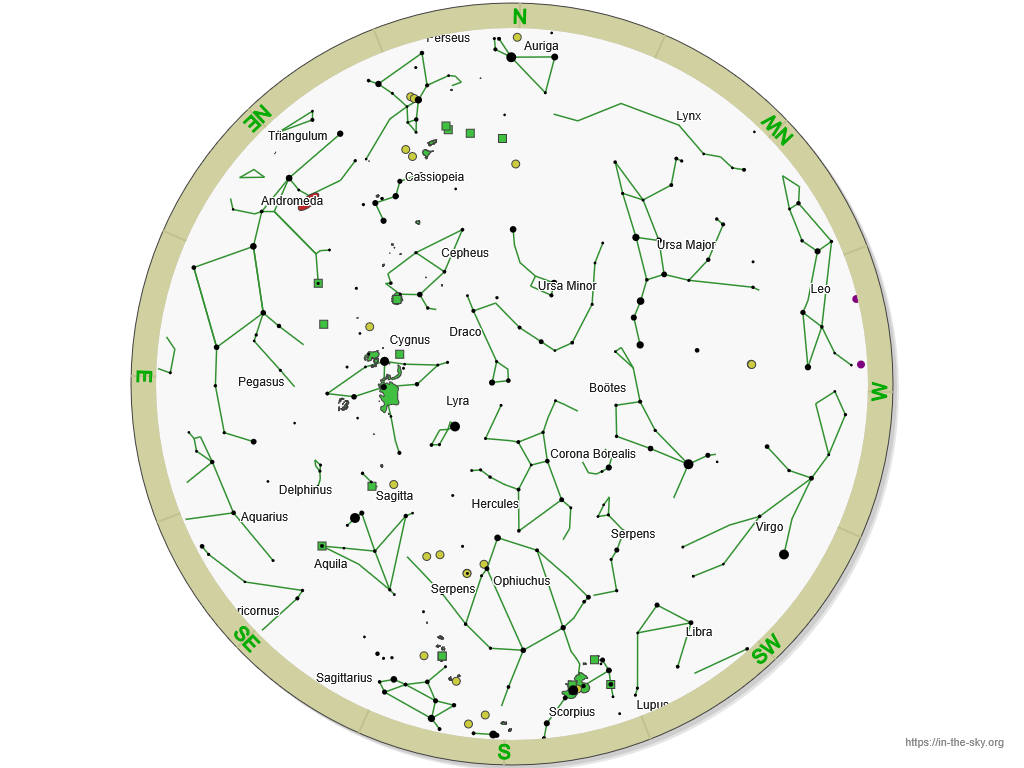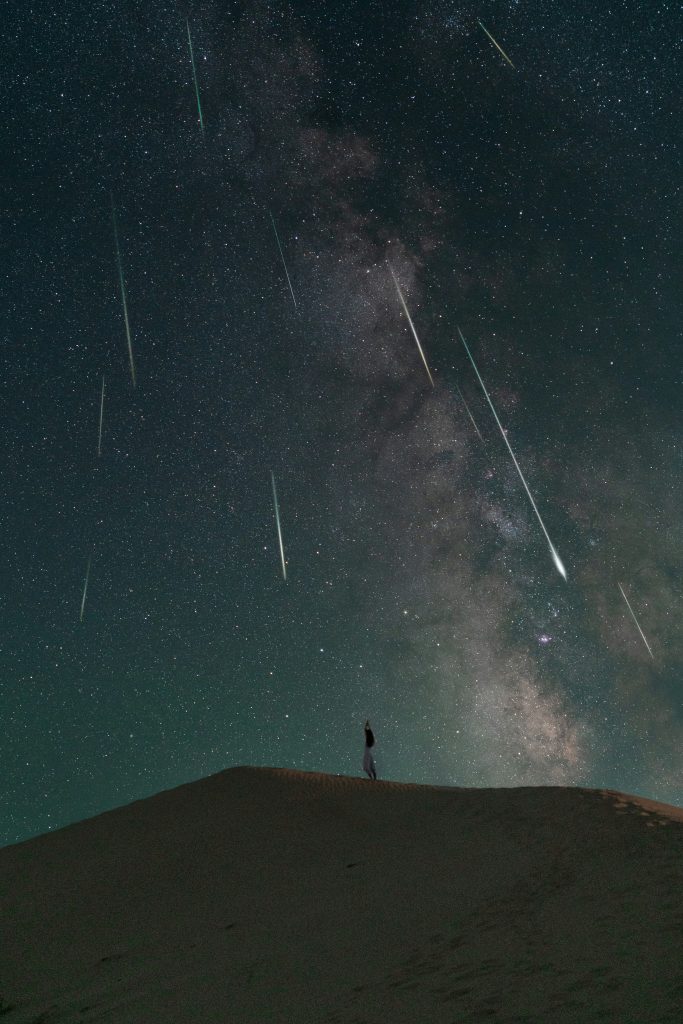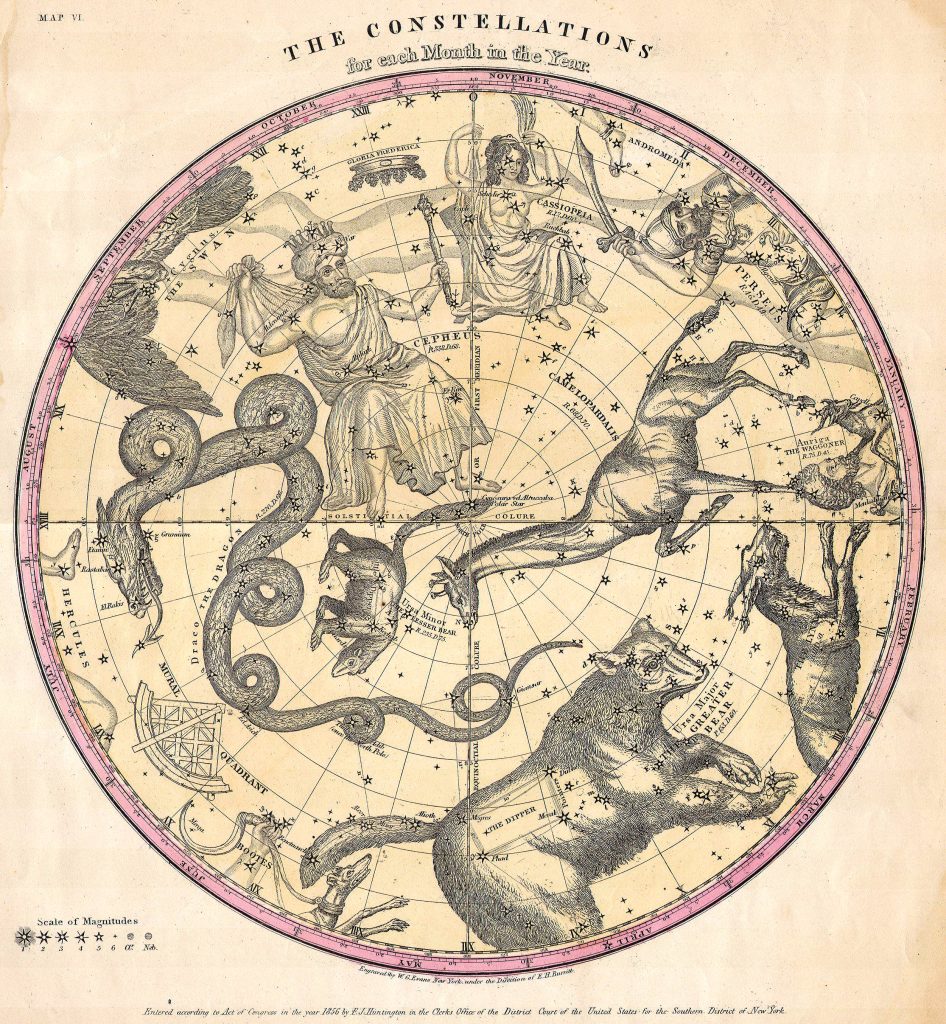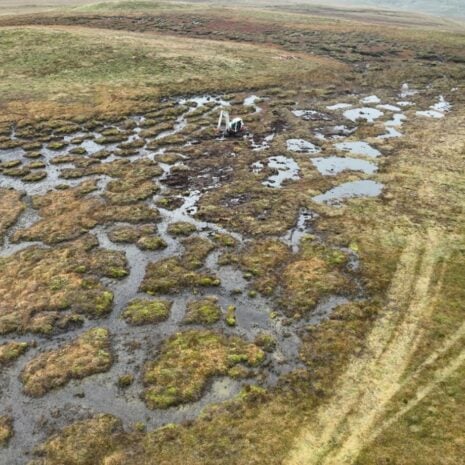Welcome to this month’s update to find out what’s in the night sky for August.
In the Elan Valley International Dark Sky Park, astronomical darkness is back – lasting for around two-and-a-half hours from midnight at the start of the month and a whopping six hours at the end, starting at 10:15pm. This means that conditions will be ideal for seeing the Milky Way in all its glory in dark sky areas, especially during the New Moon period during the last two weeks of August.

An all-sky view of the constellations from 10pm in August from in-the-sky.org

Low on the southern horizon, you will see the constellation of Sagittarius, resembling a tea pot, with Cygnus, Hercules, Ophiuchus, Aquila and Lyra well-placed above.
In the east, lie the autumn constellations of Pegasus, Andromeda and the ‘w’-shaped Cassiopeia. Westwards, Boötes starts to set.
The Full Moon occurs on 9th August and the New Moon on 23rd August.

Perseid Meteor Shower
The grandest meteor show of the year, the Perseid meteor shower, is currently underway. Starting on 17th July and ending on 24th August, it peaks on 12th August.
Unfortunately, optimal conditions will be compromised by the nearly Full Moon’s light but it is still worth getting outside to see the brighter meteors, of which there can be many.
We’ve been outside before on the 12th August during a Full Moon and some meteors can still be seen. The Moon will rise in the east at 9.50pm, which can be a glorious sight.
Whenever it is clear, try to get outside to see these shooting stars during the five-week duration of this shower, as the Earth passes through the debris left by comet Swift/Tuttle.
Credit: Howeni (@oweni)@ Unsplash

The Planets in August
Jupiter
Jupiter-watchers will have to rise early as it is currently a morning planet., rising at around 3.15am at the start of the month and 1.45am at the end.
Saturn
Saturn rises at 11pm in the east at the beginning of the month and will appear low on the eastern horizon as darkness falls at the end.
Venus
Venus rises at 2.30am in the north-east at the beginning of the month and at 1.50am at the end.
Bonus Planetary Conjunction
If you are staying up to watch the Perseid Meteor Shower on 12th August, there is a bonus surprise of a stunning planetary conjunction at around 2.45am – watch Jupiter and Venus rise together in the north-east as they are separated by a tiny 0.9 degrees of distance.


Constellation of the Month
Each month, we will feature a constellation and the mythology behind it.
There are 88 IAU recognised constellations in the night sky and around 36 that are observable in the northern hemisphere. Some of the names of the 88 IAU recognised constellations are several thousands of years old.
With the advent of science and rational thinking, and more of a focus on the observable world, stars are no longer used for the farming calendar, for navigation or conveying social or religious values.
Get outside and see if you can spot these constellations. The best time to see each constellation we feature is around 90 minutes after sunset.

Constellation of the Month – Cygnus
The constellation of Cygnus the Swan is well-placed during the month of August and can be seen in the south. It is also known as the Northen Cross because of its distinctive cross-shape.
This comprises part of the larger constellation of Cygnus and in dark skies, this can be clearly seen as a graceful swan, with long neck outstretched, caught in full flight as it soars along the Milky Way.
In Greek mythology, Cygnus was the best friend of Phaethon, who was the son of the sun god Helios. Phaethon persuaded his father to take his fiery sun chariot for a ride in the skies above the Earth. His father warned him that great skill was required to ride the chariot but Phaethon, in his youthful arrogance, convinced Helios he could indeed master the task. Granting permission, Phaethon took to the skies, but as he soared, he lost control and the chariot veered off-course, skimming the Earth and bringing heat and drought and suddenly rising high into the sky, bringing snow and ice. The damage was long-lasting, creating the scorched desert of the Sahara and boiling seas. The seasons were out of control and to save the Earth’s inhabitants, Zeus struck the chariot with a thunderbolt, causing it to plummet down into the Earth.


Cygnus was devastated by the death of his best friend and committed the rest of his life to search for Phaethon’s remains along the River Eridanus. Zeus was deeply moved by Cynus’s devotion, transforming him into a giant swan and placing him among the stars.
Eddies Coaster
An object that is surprisingly obvious through humble 10×50 binoculars is a fun asterism called Eddie’s Coaster. It resembles a short, celestial rollercoaster near the constellation of Cassiopeia.


Facing north-east, look high above the horizon for a disctinctive ‘w’-shaped pattern of stars – this is the constellation of Cassopeia. Looking at the constellation, raise your binoculars to your eyes and slowly scan around the area until you see a delicate, swirling line of tiny stars.
Telescope Challenge – Dumbbell Nebula
RA 19h 59m 35s | Dec +22° 43′ 16″
Although fairly bright and visible in small telescopes, this object can be a challenge to find, due to its location in the fairly dim constellation of Vulpecula (the fox). Sagitta, however, is more easily seen in the night sky looking like an arrow – and in between these two constellations lie the Dumbbell Nebula (Messier 27).


At 1200 light years away, this planetary nebula comprises gases that has been ejected from a star that is in its late stages of life. When an old star runs out of nuclear fuel, they expand into a red giant. Shedding its outer layers, these old stars form into a white dwarf. As the white dwarf blasts out ultraviolet radiation, it causes the surrounding gases to glow.











